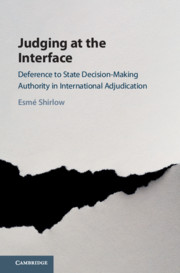Book contents
- Judging at the Interface
- Judging at the Interface
- Copyright page
- Dedication
- Contents
- Figures
- Tables
- Foreword by Judge James Crawford
- Acknowledgements
- Table of Cases
- Table of Treaties, Resolutions, and Declarations
- Abbreviations
- Introduction Deference and the International Adjudication of Private Property Disputes
- Part I Conceptual Framework and Methodological Approach
- Part II Deference in the International Adjudication of Private Property Disputes
- 4 Structures of Deference in International Adjudication
- 5 Conclusive Decision-Making Authority: Deference as Submission or Control
- 6 Suspensive Decision-Making Authority: Deference as Deferral and Abstention
- 7 Concurrent Decision-Making Authority: Deference as Restraint, Reference, and Respect
- Part III The Systemic Role of Deference in International Law
- Appendix Data Tables
- References
- Index
7 - Concurrent Decision-Making Authority: Deference as Restraint, Reference, and Respect
from Part II - Deference in the International Adjudication of Private Property Disputes
Published online by Cambridge University Press: 24 February 2021
- Judging at the Interface
- Judging at the Interface
- Copyright page
- Dedication
- Contents
- Figures
- Tables
- Foreword by Judge James Crawford
- Acknowledgements
- Table of Cases
- Table of Treaties, Resolutions, and Declarations
- Abbreviations
- Introduction Deference and the International Adjudication of Private Property Disputes
- Part I Conceptual Framework and Methodological Approach
- Part II Deference in the International Adjudication of Private Property Disputes
- 4 Structures of Deference in International Adjudication
- 5 Conclusive Decision-Making Authority: Deference as Submission or Control
- 6 Suspensive Decision-Making Authority: Deference as Deferral and Abstention
- 7 Concurrent Decision-Making Authority: Deference as Restraint, Reference, and Respect
- Part III The Systemic Role of Deference in International Law
- Appendix Data Tables
- References
- Index
Summary
A third set of approaches to deference disclose a concurrent view of authority. In the modes of ‘restraint’, ‘reference’, and ‘respect’, authority provides non-exclusionary second-order reasons for action. Second-order reasons for recognising domestic decision-making authority are treated akin to a request, rather than an order. Second-order reasons for reaching a particular decision are balanced alongside first-order reasons, rather than displacing them. Adopting this view of authority, the adjudicator is able to assert its own decision-making authority, whilst also acknowledging the decision making authority of other actors. This Chapter examines three modes of deference that reflect this understanding of the interface between domestic and international decision-making authority: the modes of deference as restraint, deference as reference, and deference as respect. Each of these approaches to deference differs from those considered in Chapters 5 and 6, because in each the adjudicator engages (even if only in a limited way) with the available first-order reasons for decision despite having recognised second-order reasons to defer to a domestic actor’s decision-making authority.
Keywords
- Type
- Chapter
- Information
- Judging at the InterfaceDeference to State Decision-Making Authority in International Adjudication, pp. 153 - 194Publisher: Cambridge University PressPrint publication year: 2021

